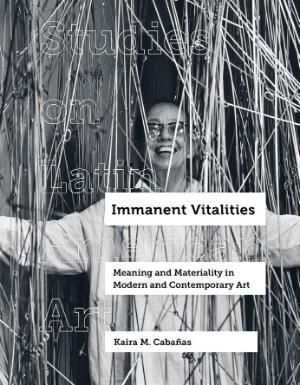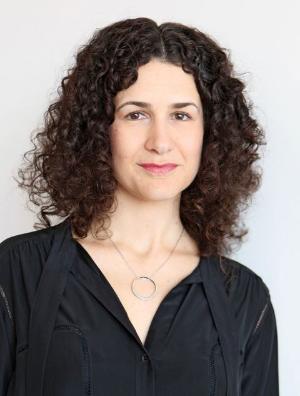 UF Center for Latin American Studies
UF Center for Latin American Studies
'Immanent Vitalities' examines Latin American art with revitalizing analysis

March 25, 2022
Little more than ten years ago, an art history education would have likely reduced Latin American art to one simple chapter: the ancient art of Mesoamerica. Dr. Kaira M. Cabañas (LAS, Art+Art History) is part of the ongoing shift by art historians to focus and expand the presence of Latin American art in an academy where it is historically underrepresented. In her most recent book, Immanent Vitalities: Meaning and Materiality in Modern and Contemporary Art, Dr. Cabañas centers Latin American art from the mid-twentieth century to the present with in-depth analysis that redefines what it means to interpret and understand works by artists from Latin America. The result of this endeavor led to a unanimous vote by the jury of the College Art Association to award Immanent Vitalities its prestigious Frank Jewett Mather Award for art criticism. Read more to learn about Immanent Vitalities and Dr. Cabañas’s vision for art history and analysis.
 Q: What led you to this topic, and to write this book?
Q: What led you to this topic, and to write this book?
CABAÑAS: One inspiration for this book is Gabriel Pérez- Barreiro’s 2006 conference on modern and contemporary art from Latin America, which he organized on occasion of the new Blanton Museum of Art’s reopening. The event was notable for bringing together leading professionals in the field—artists, curators, and academics. As I describe in the preface to Immanent Vitalities, I vividly recall the moment when Waltercio Caldas pulled a piece of plastic out of his pocket, setting it on the table next to him and Gabriel during their public conversation. Suddenly the plastic began to shift, its creases unraveled, and its semi-opacity became increasingly translucent. The material came alive before the public’s eyes. I do not remember what Caldas was responding to at that specific moment, but I imagine, given his unique mode of presentation, that he was doubling down on how materiality impinges on artistic representation as well as on art’s perception. Here materiality trumped verbal discourse on art, and since then the “magic” of the material that he pulled out of his pocket has lived on in my thinking such that this scene has unwittingly served as a point of departure for some of the concerns articulated in my book.
Q: What do you want readers to understand after reading your book?
CABAÑAS: It is important for readers to understand that Immanent Vitalities does not presume to provide a continuous genealogy from global modern to contemporary art. In each chapter I focus on a representative case of artistic production in which an artist seems to begin her work by asking what can art as a material object and practice do (rather than exclusively what art is). This distinction is key. My aim with Immanent Vitalities is to prompt readers to rethink materiality through artistic practices so as to affirm what escapes aesthetic representation (and, by extension, philosophical representationalism), while remaining attentive to social differences and lived experience.
Q: Who is the audience of your book? Why was it important to write toward that audience?
CABAÑAS: Immanent Vitalities addresses a growing market in art history and the art world more generally for new perspectives on the history of modern and contemporary art, the art of Latin America, and new materialisms. My hope is that the book’s interdisciplinary reach makes it a valuable reference for courses on modern thought, Latin American culture, new materialist aesthetics, curatorial studies, and aesthetics and politics. This said, I also write with an eye to less specialized audiences. I aim for my books to be readable not jargon filled. The latter is important if one hopes to capture readers beyond the academy. In writing the book, I imagined its interest would also encompass museum professionals, including curators and educators, as well as students interested in modern and contemporary art in general.
Q: How has your perspective as a Latinamericanist informed your experience as an art historian?
CABAÑAS: Written from the perspective of the academy in the United States and with that public in mind, Immanent Vitalities contributes to a less geopolitically oriented approach to the modern and contemporary art of Latin America. I propose that the cumulative effect of an approach that takes geopolitical alignments and international cultural policy as the primary framework for how art signifies has been, paradoxically, to isolate Latin America as a separate geographic and self-sufficient field. The approach has also produced an implicit academic bias: When one writes about the modern and contemporary art of Latin America, one needs to provide more cultural context (to let geopolitics lead the way), while theoretically informed art history seems to remain doggedly within the purview of (Euro-American) modernist art histories. In short, one can write field changing work as a Latinamericanist and claim one’s work as a central to shaping the discipline of art history and its stakes.
 Q: What challenges and opportunities do you find as a scholar who works at the intersection of so many disciplines, each with their own lenses for interpretation and analysis?
Q: What challenges and opportunities do you find as a scholar who works at the intersection of so many disciplines, each with their own lenses for interpretation and analysis?
CABAÑAS: That’s a complex question, deserving of a complex answer. First, I think it is important to aim for intensive knowledge and to understand the contours and evolution of a specific problematic across disciplines, so that one does not merely cherry pick ideas that suit and illustrate one’s analysis. Turning to different analytical and disciplinary lenses offers an opportunity to challenge what one thinks one knows. I find this has been a pleasure and challenge for practicing a different type of art history and is at the center of my current project Deviant Art Histories, which explores intersections of art and psychiatric reform in different geographic regions. As I ask in the manuscript in progress: what can art history become when one looks at art and its histories as produced under different institutional, cultural, colonial, and psychic conditions? My aim has been to un-discipline art history by revealing its entanglement with adjacent histories in order to recover forms of agency and write more inclusive histories.